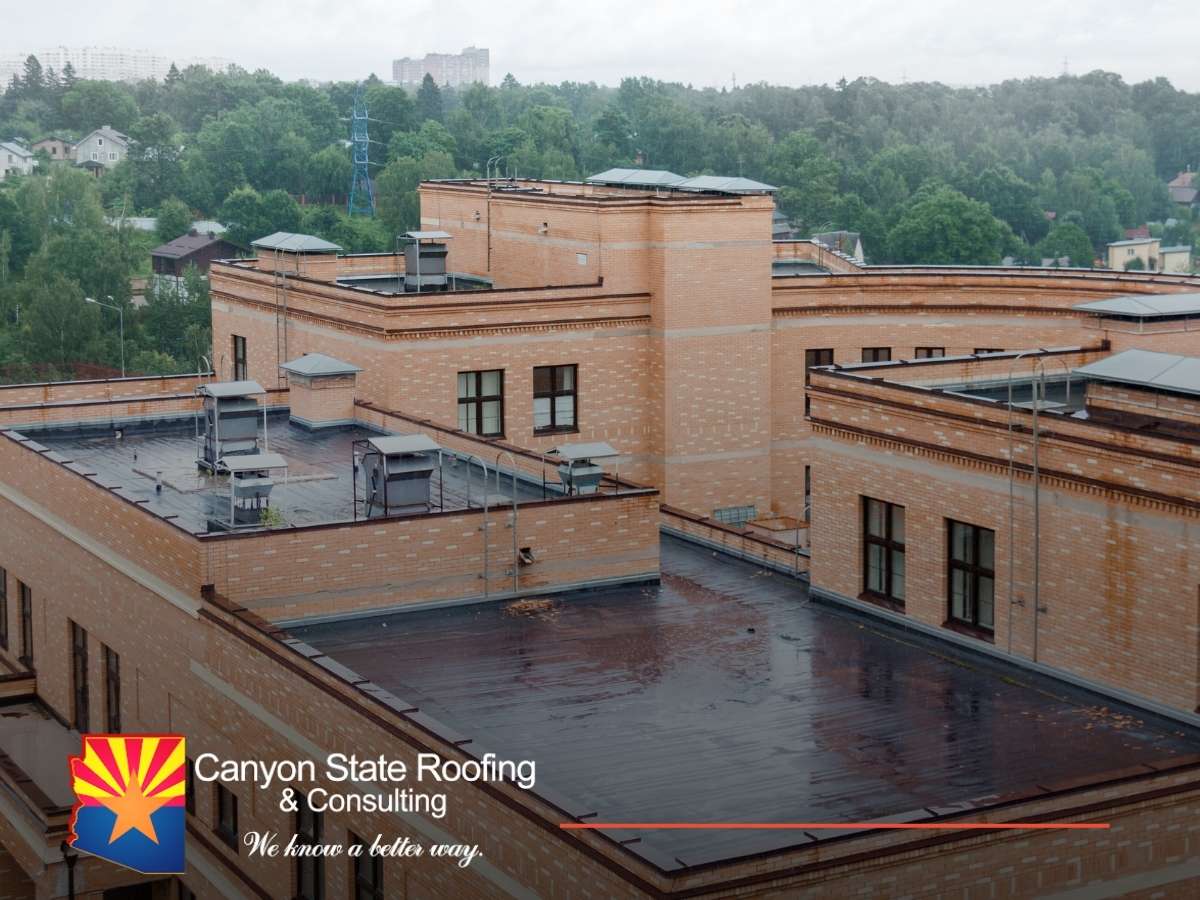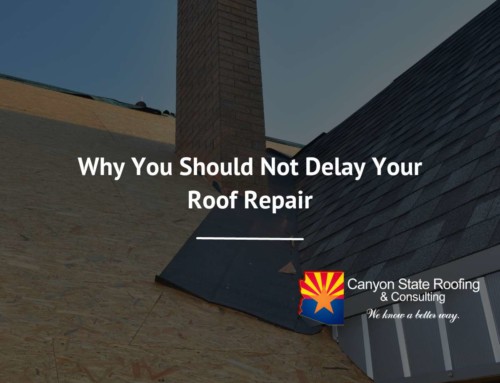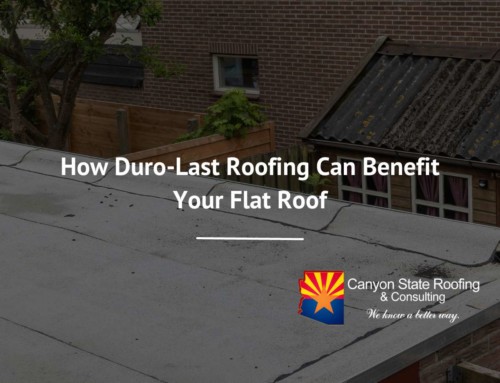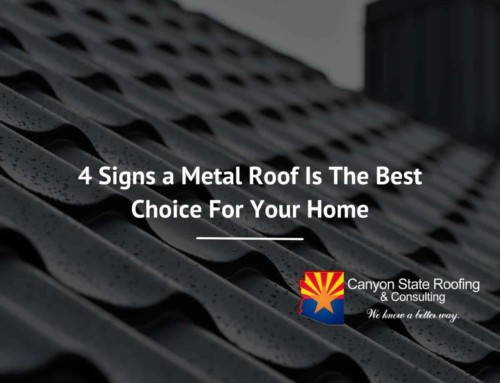Table Of Contents
- Giving Maintenance To Your Commercial Flat Roof
A Complete Guide To Commercial Flat Roof Maintenance: Common Issues & How To Fix Them
Giving Maintenance To Your Commercial Flat Roof
Commercial flat roof maintenance in Phoenix requires more than just quick fixes. It requires a proactive approach to protect your building, preserve your investment, and avoid the headaches that come with unexpected repairs. Arizona’s intense heat, sudden storms, and changing seasons can wear down even the toughest roofing systems over time.
In this guide, we explore the most common maintenance challenges for commercial flat roofs and share practical tips to help you stay ahead of potential problems. Whether you’re managing office spaces, warehouses, or multi-use facilities, knowing how to care for your roof can help you prevent damage, reduce costs, and extend the life of your property.

Types Of Commercial Flat Roofs
Before explaining the different issues in flat roofs, let’s take a look at some of the most common types in the commercial industry:
- Built-Up roofing (BUR): Consists of multiple layers of bitumen (asphalt or coal tar) alternated with layers of reinforcing fabrics.
- Modified bitumen roofing:It’s similar to BUR, but uses modified bitumen membranes that are applied as rolls.
- Thermoplastic Polyolefin Roofing (TPO): Commercial TPO roofings use a single-ply membrane system, meaning that they use a single layer of this synthetic polymer-based material as the roofing membrane.
- Ethylene Propylene Diene Monomer (EPDM): EPDM roofings are another type of single-ply membrane system, but this time made of a synthetic rubber.
- Metal Roofing: Metal roofings can be constructed from various metals like steel, aluminum, or copper.
- Spray Polyurethane Foam (SPF): This system is applied as a liquid, and then it expands into a foam that creates a solid layer.
Common Problems With Commercial Flat Roofs
Despite the differences in materials and installation methods, flat roofs all share one key characteristic: they’re vulnerable to specific problems due to their minimal slope and constant exposure to the elements.
Whether you have BUR, modified bitumen, TPO, EPDM, metal, or SPF roofing, the following issues are among the most common you might encounter throughout your roof’s lifespan:
Standing Water
Ponding is the biggest problem for many flat roofs. Water will always find its way out, even if the roof has a slope. You probably don’t want water running through the ceiling, so you must act carefully.
Moisture can cause dips, divots, mold, and other problems in your roofing material, regardless of its duration.
One way to deal with ponding is to act fast after it rains. Use a mop or squeegee to push water away and let your roof dry under the sun. Make sure the roof’s drainage is free and not clogged. Clogged drains prevent water from escaping the roof, worsening the problem.
Clear pipes and gutters to prevent clogged drains, and reach out to a trusted Phoenix commercial roofing contractor like Canyon State Roofing to ensure your roof is in good condition.
Roof Degradation
You cannot avoid degradation. It happens to every material, even those with a long lifespan and resistant surfaces. However, extreme heat and cold can speed up the process.
You can fight its effects with regular inspections. Contact a Queen Creek roofing contractor at least once a year to check your roof and ensure it’s in great condition. The contractor can also inform you about potential issues, including bending and leaking.
Before calling the professional, you can see if the roof material is drying out or flaking every few months. If that’s the case, get them patched up as soon as possible. The sooner you solve degradation issues, the better the chances of minimizing worse damage.
Tears, Scuffs, & Holes
Flat rooftops serve as event spaces for many tenants. The problem is that it creates a lot of traffic, increasing the chances of getting scuffs, tears, and holes. Small scratches aren’t a big problem initially, but they may expand over time.
The best way to deal with tears, holes, and scuffs is by preventing them. Build proper walking paths so that tenants and guests walk through safe areas and not sensitive parts of the rooftop.
If you see any scuffs, fix them with material or contact a professional.
Debris
Flat roofs collect debris like dirt, leaves, small branches, and even trash as time goes by. Occasional litter doesn’t hurt your roof, but debris buildup can be dangerous when unattended, especially if you don’t contact a Glendale roofing company on time.
Trash and leaves can clog drains, causing ponding and drainage pipes weakness.
Luckily, debris buildup is easy to fix. Sweep your roof with a leaf blower, or try pressure washing to get rid of debris. Use soapy water to clean off mud and dirt if necessary. If the debris clogs your pipes and gutter, contact a professional immediately.
Roof Leaks
One of the most common problems on any type of roof is leaking. It happens when standing water has nowhere to go and it’ll seep through the rooftop. Water has nowhere to run but down when there’s no place for it.
Sadly, this can happen even with the most resistant roofing materials. Moisture affects the surface enough to develop fungus and mold. When mold and fungus worsen, the water finds its way to your ceiling and creates leaks.
To prevent it, drain standing water any time you can. You should also check for holes and tears that may let the water go through your rooftop. The sooner you solve these issues, the lower the chances of developing leaks.
Signs Your Flat Roof Needs Maintenance
Knowing the warning signs of flat roof damage can save time, money, and prevent costly structural issues in the future. Just like any other roofing system, flat roofs are exposed to external elements year-round, so it’s important to stay vigilant and act quickly when problems appear. Here’s how to know your roof needs repairs:
- Visible cracks or blisters: Surface cracks, bubbling, or blistering in the roofing membrane often indicate trapped moisture or aging materials.
- Water stains: If you notice water stains on ceilings or upper walls, it likely means water is seeping through your flat roof.
- Membrane lifting or seams separating: Lifting edges or gaps at seams can allow water infiltration and should be repaired as soon as possible.
- Mold, mildew, or musty smells: These can signal hidden moisture problems beneath the roof surface.
- Increased energy bills: A failing flat roof may lose insulation efficiency, causing heating and cooling systems to work harder.
Seasonal Maintenance Tips
Recognizing the warning signs of damage is only part of protecting your flat roof. To keep your roofing system in optimal condition and avoid unexpected problems, regular seasonal maintenance is essential. Proactive care throughout the year can help prevent small issues from becoming costly repairs while extending the lifespan of your investment. Below are practical maintenance tips you can follow each season to ensure your flat roof stays in top shape.
Spring Checklist: Recovery & Inspection
- Inspect for damage caused by any previous storms
- Clear all debris from drains, scuppers, and gutters
- Check for signs of ponding or standing water
- Examine membrane for cracks, punctures, or UV damage
- Trim overhanging branches to prevent debris accumulation
- Schedule a professional inspection to identify hidden issues
Summer Checklist: Heat & UV Protection
- Inspect flashing and seals for cracks from heat expansion
- Check for blistering or bubbling on the membrane
- Ensure proper drainage before monsoon or rainy seasons
- Clean rooftop HVAC units and remove accumulated debris
- Apply protective coatings if needed to reflect UV rays
Monsoon Season Checklist: Protection Against Humidity
We do know that monsoon season is also part of summer, but it requires extra tips to properly take care of your roof. Here’s our checklist:
- Inspect the roof after heavy rainfall for leaks or soft spots
- Ensure all drainage systems are working properly
- Clear out gutters and scuppers before and after major storms
- Monitor for signs of mold, mildew, or foul odors
- Recheck roof penetrations (vents, pipes) for proper sealing
Fall Checklist: Preparation For Cold Weather
- Remove leaves and organic debris that can clog drains
- Inspect insulation and membrane condition
- Repair any minor damage before low temperatures appear
- Confirm flashing and edge details are secure
- Schedule preventative maintenance
Cost of Neglecting Maintenance
Ignoring flat roof maintenance can lead to expensive consequences, especially if you don’t schedule a professional roofing check at least once a year. Small issues like minor leaks or clogged drains often worsen over time, resulting in water damage, insulation failure, and even structural deterioration.
In other words, what could have been a simple patch job may escalate into the need for major repairs or a full roof replacement. That, of course, costs significantly more than routine upkeep.
Neglected damage can also disrupt business operations, cause inventory loss, and increase energy bills due to compromised insulation performance. For this reason, many property managers rely on scheduled maintenance programs to help extend the life of their roofing systems and reduce long-term costs. These programs, often offered by experienced commercial roofing contractors, are designed to catch small problems early before they turn into something more serious.
Call A Phoenix Roofing Company For The Best Repair
You may solve small issues in your flat roof, but most of the time, you need a pro on your side to fix leaks, tears, holes, and other roofing issues. Contact Canyon State Roofing for reliable commercial flat roof inspections and maintenance in Phoenix. Our team helps property managers protect their investment with proven solutions. Call us today at 602-400-1635.
Frequently Asked Questions About Commercial Flat Roof Maintenance
How Often Should A Commercial Flat Roof Be Inspected?
- Twice a year is the best approach. You can schedule one appointment in the spring and another in the fall. You may need additional inspections after heavy storms or extreme weather to prevent costly repairs. At Canyon State Roofing in Phoenix, AZ, we offer maintenance programs and routine inspections designed to help property managers stay ahead of potential issues and protect their investment long term. Call us at 602-400-1635 to schedule your next inspection.
How Can I Tell If My Flat Roof Needs Repair Or Replacement?
- Signs like frequent leaks, ponding water, blistered membranes, or visible damage are among the most common. If issues are widespread or the roof is over 20 years old, it may need replacement.
Can Standing Water Damage A Flat Roof?
- Yes, standing water can cause the roofing material to break down, lead to leaks, and promote mold or algae growth. Over time, it can compromise the structural integrity of the roof.
What Is The Best Way To Prevent Flat Roof Leaks?
- You can prevent leaks by cleaning drains, sealing cracks early, inspecting seams and flashing, and scheduling regular maintenance to catch small problems before they become bigger.
How Much Does Commercial Flat Roof Maintenance Cost?
- Costs vary, but basic maintenance ranges from $0.10 to $0.75 per square foot. Prices depend on roof type, condition, and whether repairs or special treatments are needed. Feel free to contact us for more detailed information regarding pricing.

Canyon State Roofing
4809 E Thistle Landing Dr #100
Phoenix, AZ 85044
Office: 602-400-1635
Email: [email protected]
Website: www.canyonstateroofs.com





